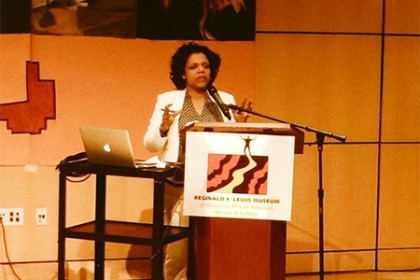During a panel discussion Wednesday evening, public health experts explored more than a century of discriminatory public policy in Baltimore, and the results: two Baltimores with extreme—and life-threatening—health disparities for residents.

Image caption: Debra Furr-Holden
Speaking at the second event of the Redlining Baltimore conversation series sponsored by Johns Hopkins University's 21st Century Cities Initiative, Lawrence Brown, an assistant professor at Morgan State University's School of Community Health and Policy, began the discussion with an overview of the history of redlining, a term that has come to refer to a variety of discriminatory practices meant to block access to public services based on race. Brown noted that in the early part of the 20th century, Baltimore mayors J. Barry Mahool, James H. Preston, and Howard W. Jackson began redlining in Baltimore during the Jim Crow era as a means of segregating the city.
"Baltimore is ground zero for Apartheid in America," he said.
Brown described the resulting redlined districts as a "White L" along the Charles Street corridor and east along the Inner Harbor, and a "Black Butterfly"—swaths of "undesirable" minority neighborhoods extending out from the L in the shape of butterfly wings.
Debra Furr-Holden, an adjunct professor in the Johns Hopkins Bloomberg School of Public Health, used the map depicting the White L and Black Butterfly to overlay data showing incidents of non-fatal gun violence and liquor store locations, demonstrating that even a century after the redlining of districts, the effects persist in the public health crises of Baltimore.
For example, in "undesirable" districts, gun crime is so prevalent that the red data markers on the map overlapped, sometimes two or three times over. Predictably, liquor store locations are also more prevalent in these areas, densely distributed within communities. In predominantly white neighborhoods, on the other hand, liquor stores tend to be limited to clusters along major roadways, for the convenience of commuters, Furr-Holden said.
Furr-Holden pointed out zoning disparities in the city, noting that officials can use zoning to marginalize and endanger communities. She mentioned a survey of Baltimore City Public School students that revealed that whereas only 13 percent live within walking distance of a food market, more than 50 percent live within walking distance of a liquor store. But she said she remains hopeful for a change.
"We are in our first comprehensive zoning rewrite," she said. "If we can reduce alcohol outlet density in Baltimore City by 20 percent, it would be the single greatest thing we could do to reduce violence in the city."
Panelist Sonia Sarkar, chief policy and engagement officer for the Baltimore City Health Department and a Johns Hopkins alum, noted that in a city with some of the best health institutions in the country—including Johns Hopkins—the average life expectancy in certain neighborhoods in Baltimore is lower than the average life expectancy in Rwanda and Nepal.
Richard Best, founder of the nonprofit organization Section1 that works to transform blighted and abandoned city spaces into cultural destinations, also spoke, discussing the power of art. Baltimore City, he said, spends approximately three dollars per resident on reactively cleaning up graffiti. Instead, he argued, the arts should be leveraged to improve the health of communities. He told a story about a meeting between an artist and a surgeon, during which the artist said "You save peoples' lives; I give them a reason to live."
Still, inspiring communities is only half of the battle, panelists agreed. City officials and public institutions must act to correct the far-reaching effects of redlining.
"We have problems that are systematic and structural," Furr-Holden said. "If we don't deal with them at a systematic and structural level, it's like putting icing over mud. It doesn't make it a cake."
Wednesday's discussion, titled "Experience: Public Health and the Red Line," was the second installment of the four-part conversation series, which is hosted by actress Sonja Sohn and aims to bring together experts, students, artists, and community members to discuss the history and persisting effects of structural racism. The final two events in the series are "Opportunity: Inclusive development and wealth creation inside the redline," on April 20; and "Transform: The future of justice and knowledge of the Redline," on May 4.
Posted in Health, Politics+Society
Tagged health disparities, 21st century cities, redlining baltimore











